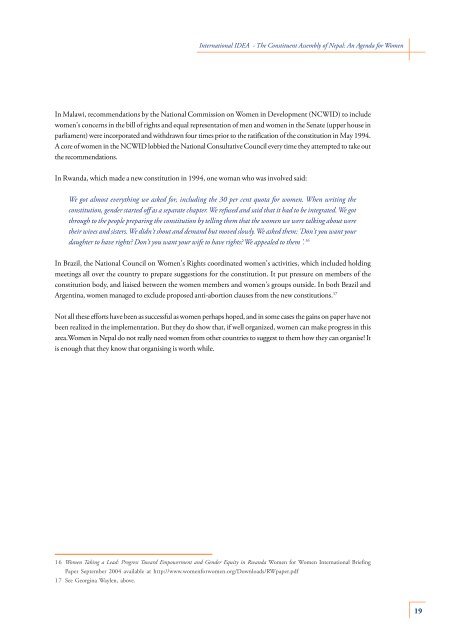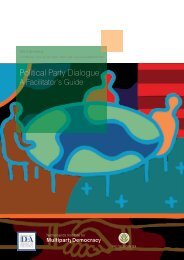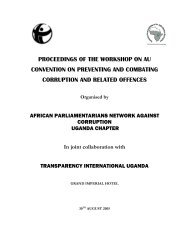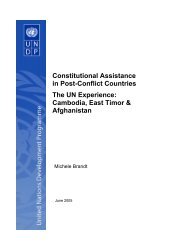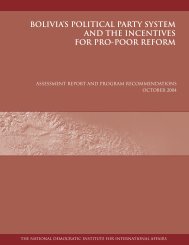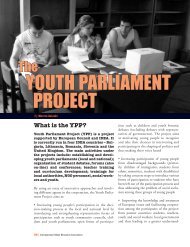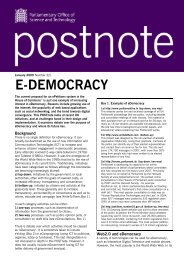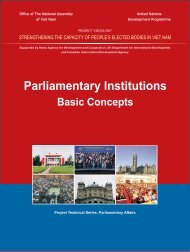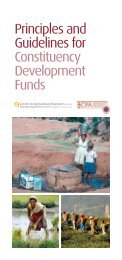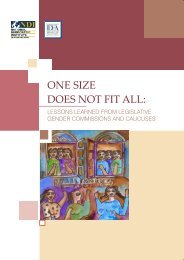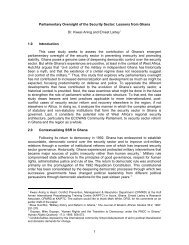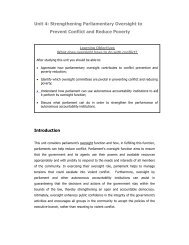The Constituent Assembly of Nepal: An Agenda for Women - CAPWIP
The Constituent Assembly of Nepal: An Agenda for Women - CAPWIP
The Constituent Assembly of Nepal: An Agenda for Women - CAPWIP
- No tags were found...
Create successful ePaper yourself
Turn your PDF publications into a flip-book with our unique Google optimized e-Paper software.
International IDEA - <strong>The</strong> <strong>Constituent</strong> <strong>Assembly</strong> <strong>of</strong> <strong>Nepal</strong>: <strong>An</strong> <strong>Agenda</strong> <strong>for</strong> <strong>Women</strong>In Malawi, recommendations by the National Commission on <strong>Women</strong> in Development (NCWID) to includewomen's concerns in the bill <strong>of</strong> rights and equal representation <strong>of</strong> men and women in the Senate (upper house inparliament) were incorporated and withdrawn four times prior to the ratification <strong>of</strong> the constitution in May 1994.A core <strong>of</strong> women in the NCWID lobbied the National Consultative Council every time they attempted to take outthe recommendations.In Rwanda, which made a new constitution in 1994, one woman who was involved said:We got almost everything we asked <strong>for</strong>, including the 30 per cent quota <strong>for</strong> women. When writing theconstitution, gender started <strong>of</strong>f as a separate chapter. We refused and said that it had to be integrated. We gotthrough to the people preparing the constitution by telling them that the women we were talking about weretheir wives and sisters. We didn't shout and demand but moved slowly. We asked them: 'Don't you want yourdaughter to have rights? Don't you want your wife to have rights? We appealed to them '. 16In Brazil, the National Council on <strong>Women</strong>'s Rights coordinated women's activities, which included holdingmeetings all over the country to prepare suggestions <strong>for</strong> the constitution. It put pressure on members <strong>of</strong> theconstitution body, and liaised between the women members and women's groups outside. In both Brazil andArgentina, women managed to exclude proposed anti-abortion clauses from the new constitutions. 17Not all these ef<strong>for</strong>ts have been as successful as women perhaps hoped, and in some cases the gains on paper have notbeen realized in the implementation. But they do show that, if well organized, women can make progress in thisarea.<strong>Women</strong> in <strong>Nepal</strong> do not really need women from other countries to suggest to them how they can organise! Itis enough that they know that organising is worth while.16 <strong>Women</strong> Taking a Lead: Progress Toward Empowerment and Gender Equity in Rwanda <strong>Women</strong> <strong>for</strong> <strong>Women</strong> International BriefingPaper September 2004 available at http://www.women<strong>for</strong>women.org/Downloads/RWpaper.pdf17 See Georgina Waylen, above.19


